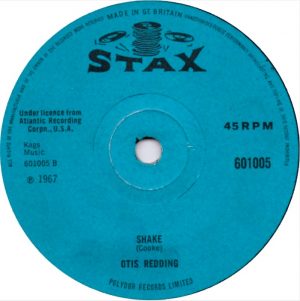In 1965, Otis Redding’s Otis Blue/Otis Redding Sings Soul rewrote the soul rulebook – a blistering, vibrant collection of originals and covers that would become his defining LP…
It’s not often that an album largely made up of covers acquires hit status. But for some artists, their stamp on that second-hand material is so definitive, so peerless, that the album becomes as much theirs as anything else in their discography. So it is with Otis Blue, the third long-player from one of 60s soul’s grittiest, hardiest voices.
Otis Redding was, of course, no stranger to the cover version. He’d essayed other artists’ songs on both his first two records, including Rufus Thomas’ The Dog, Richard Berry’s Louie Louie, Little Richard’s Lucille and Ben E. King’s Stand By Me.

Raising Standards
But when we remember Stand By Me now, or Lucille, it’s not Redding’s version that comes to mind. They’re decent covers, sure, but none surpass the originals. Yet there are versions on Otis Blue that have become standards in themselves. Redding’s take on The Rolling Stones’ Satisfaction is brave enough to do something completely different with the song, and it stands absolutely distinct from Mick and Keith’s 1965 original. Ditto his version of B.B. King’s Rock Me Baby, one of the most recorded blues tracks of all time, but totally owned by Otis Redding.
Of course, we shouldn’t forget that Otis Blue isn’t just covers. Three of the LP’s 11 songs were penned or co-penned by Redding himself, and three others by fellow soulster Sam Cooke, who had died several months before the album was recorded. And it’s worth remembering that Aretha Franklin’s biggest hit, Respect, began its life on this record. Written by Redding, it netted the Georgia-born singer a Top 40 hit. Aretha’s version may be considered the definitive recording, but without Otis Blue, it’s a real question as to whether the Queen Of Soul would ever have broken through (Respect would be Franklin’s first No.1).
Otis Redding had already been at Stax for three years by the time Otis Blue was released. But his first two albums, 1964’s Pain In My Heart and March 1965’s The Great Otis Redding Sings Soul Ballads, had failed to break the Billboard Hot 100.
Stax Of Talent
But Stax Records president Jim Stewart had unwavering trust in his signing and what would become Otis Bluehit record stands just six months after his sophomore effort. It would be the album that finally broke Otis Ray Redding Jr, hitting No.75 in the US (plus No.1 on the R&B chart) and an amazing No.6 in the UK. Not bad for an album that took just 24 hours to record (to put this in perspective, The Beatles’ Rubber Soul, which followed that December, was a month in the making).
Redding entered Stax’s recording studio in Memphis on 9 July 1965, backed by the label’s house band Booker T. & The M.G.’s (keyboardist/bandleader Booker T. Jones, guitarist Steve Cropper, bassist Donald ‘Duck’ Dunn and drummer Al Jackson Jr.), plus Isaac Hayes (yes, that one) on piano, and a horn section consisting of members of The Mar-Keys and The Memphis Horns.
“It was [intense], but he [Redding] seemed to be possessed at that time,” Booker T. Jones reflected to The Guardian in 2013 about the fast-paced recording of the album. “Nobody was quite sure what was going on with him. He just seemed to be in a hurry. Not a hurry – obsessed. And we didn’t understand why. We just went along with it. If he wanted to go for 24 hours we just did it.”

Got To, Got To Have It
Side One kicks off with the mournful, reflective Ole Man Trouble, written by Redding and released as the B-side to Respect later in ’65. It’s a track that seems to point the way towards Redding’s most famous number, (Sittin’ On) The Dock Of The Bay. It’s an achingly beautiful opener, and was the first indication of the singer’s broadened musical palette.
Anyone familiar with Aretha’s powerhouse version of Respect would be surprised at quite how spare Otis’ original is. Though Redding is credited as writer, its actual origins are somewhat murkier. According to blues lore, the song was apparently brought to Redding by Earl ‘Speedo’ Sims (though he was unsure as to who’d written it), who planned to record it with his band, The Singing Demons. Redding took Sims’ version, rewrote the lyrics and sped up the tempo.
The Singing Demons then went to Muscle Shoals studios to record this new version, though nothing came of the session. Redding then decided to perform the song himself, which Sims said yes to, agreeing to credit Sims, only this never happened. And of course, by the time Franklin recorded her version it had been changed even more (the ‘sock it to me’ section was dreamed up by Aretha and her sister Carolyn), so Respect is one of the pop classics that evolved considerably over time.
Rock Me Baby
Change Gonna Come is a spirited cover of Sam Cooke’s slightly-differently-titled A Change Is Gonna Come, which had originally appeared on Cooke’s 1964 album Ain’t That Good News, while Rock Me Baby has, over the decades, become one of the most recorded blues songs of all time. Written by Joe Josea and B.B. King and based on Lil’ Son Jackson’s 1951 composition Rockin’ And Rollin’, it would be King’s first Top 40 hit.
Satisfaction is the one cover that really sticks out. The Rolling Stones had embraced their blues roots at the start of their career, covering numbers by, among others, Rufus Thomas and Willie Dixon, but by the time Mick Jagger and Keith Richards started writing their own songs, they’d moved more into rock-pop waters. So when Otis Redding got his hands on the band’s (I Can’t Get No) Satisfaction, he gave it a thorough soul makeover.
“I use a lot of words different than the Stones’ version,” Redding noted to Rolling Stone magazine. “That’s because I made them up.” Of that session, Steve Cropper remembered to Rolling Stone: “If you ever listened to the record you can hardly understand the lyrics, right? I sat down next to a record player and copied down what I thought the lyrics were and I handed Otis a piece of paper and before we got through with the cut, he threw the paper on the floor and that was it.”

Rockin’ The Studio
Otis Blue climaxes with the tingling You Don’t Miss Your Water, probably the best-known number from another Stax signing, William Bell. This one has been covered many times, notably by Percy Sledge, The Byrds and Jerry Lee Lewis, but it’s Otis Redding’s delivery which tugs at the heartstrings most effectively. It may be Bell’s signature song, but it’s Redding’s version we still talk about.
The speed in which Otis Blue was made is certainly a contributing factor to its vibrancy. As Steve Cropper revealed to Clash Music, there was certainly a lack of preparation when the various musicians initially entered the recording studio.
“So we were all in there ad-libbing together on a song that sometimes we had never played before,” the guitarist reflected. “Some of the guys maybe had played versions in a club somewhere, but that was about it… So we head-arranged, and what we would do, we would run the tape, and a lot of times I would come up with a riff and put it on the end and I would say, ‘Guys, can we use that riff for the intro then we hit on it during the song?’ Instead of starting at the top and working our way down, which we had done many times, a lot of times we would get to the end and this repetitive lick would come over and over and over, so we would go to the front and put it on the intro.”
Got It Covered
Otis Blue was released on 15 September 1965, just two months after its recording. Issued by Volt in the US and Atlantic in the UK, its cover featured a blonde-haired white woman, a photo that was a library shot and had no other information as to the model’s identity (though some believe it to be German model Dagmar Dreger).
Although Otis Blue only reached No.75 on the main albums chart in the States, four of its singles charted on the Billboard Hot 100 – I’ve Been Loving You Too Long (No.21), Respect (No.35), Satisfaction (No.31) and Shake (No.47). My Girl, meanwhile, was released in the UK only, achieving a position of No.11.
To modern ears, it seems strange reading a tracklisting from such titanic names as Otis Redding and to see that so many of the songs are covers. But as Rob Bowman, author of Soulsville USA, told Clash Music: “In 1965, Black artists especially, but even more white artists than people realise, were still doing a significant number of covers. Many artists didn’t write any of their own material.

A Bona Fide Star
“The originals they did were written for them by professional songwriters – Black or white… It’s not until about ’67, a couple years after Otis Blue, that you start seeing white rock artists writing most of their own material, and it’s a little longer before a number of Black artists – whether it be Stevie Wonder, Marvin Gaye, George Clinton or Isaac Hayes – start to emerge as album-oriented artists.
“It was really around ’69 that they were writing all their own material. So at the time they cut Otis Blue, the practice of mostly covers with your current hit singles was pretty common.”
Otis Blue’s success made Otis Redding into a bona fide star and today stands tall as one of the defining albums of the 1960s. In 2003, the record was ranked at No.74 on Rolling Stone’s 500 Greatest Albums Of All Time.
Gone Too Soon
Otis would release another three long-players after this – The Soul Album (1966), Complete & Unbelievable: The Otis Redding Dictionary Of Soul (1966) and, with Carla Thomas, King & Queen (1967) – but it’s Otis Blue that most still talk about. It’s the album that introduced Otis Redding to those outside of the soul music hardcore and established him as one of the great soul voices.
Many albums waxed in record time only suffer because of it – they can sound rushed or incomplete. Otis Blue, however, sounds urgent and live.
Just two years and a half years on from recording his magnus opus, Otis Redding was dead. But with Otis Blue that dramatic, sand-powered voice will live on forever.

Live Forever
Otis Redding was just 26 years old when the plane in which he was travelling crashed in Wisconsin’s Lake Monona. The singer had been gigging around America at the time of his death and on 10 December 1967 had been scheduled to play at the Factory nightclub in Wisconsin, near the city’s university. Except he never made it there.
The weather that the Beechcraft H18 aircraft took off in was horrendous – heavy rain and fog – and Redding and his entourage were advised not to fly. Tragically, the plane crashed shortly before they reached their destination of Truax Field in Madison. The cause of the crash was never determined, though there was one survivor – Bar-Kays member Ben Cauley. Seven people died – Redding, plus Bar-Kay guitarist Jimmy King, tenor saxophonist Phalon Jones, organist Ronnie Caldwell, and drummer Carl Cunningham; their valet, Matthew Kelly; and the pilot Richard Fraser.
More than 4,500 people came to Redding’s funeral at the City Auditorium in Macon, Georgia, overflowing the 3,000-seat hall. Just a month later, (Sittin’ On) The Dock Of The Bay was released, becoming Redding’s only single to reach No.1 on the Billboard Hot 100 and the first posthumous chart-topper single in US history.
For more on Otis Redding click here
Buy Vintage Rock Presents The Sound of Soul






